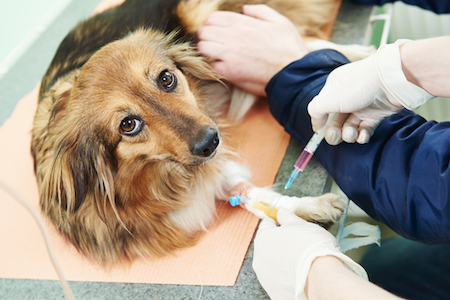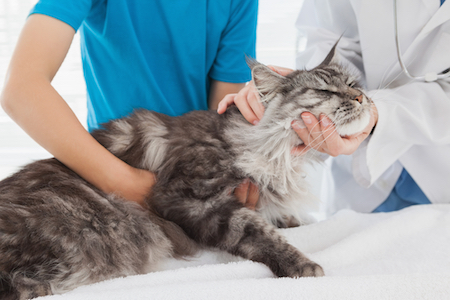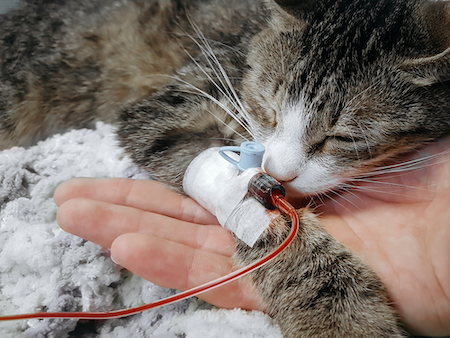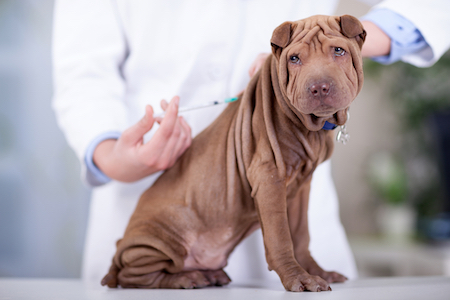Pet Wellness Guides > Early Cancer Detection in Pets - Pet Insurance Review
Early Cancer Detection in Pets
Posted: 08/24/2022 | BY: Erin Cain | Categories: Cat , Dog , Health problems , Pet care , Top Tips
Most pet parents want to do everything they can to keep their furry friends healthy and cancer-free. Unfortunately, cancer is one of the most common diseases in pets, affecting nearly half of all dogs over the age of ten. The good news is that early detection is often enough to cure cancer, so it’s essential to be on the lookout for any signs or symptoms. Let’s discuss the steps that pet parents can take to help prevent cancer in their dogs and cats and ensure early detection if it does occur.

Early Cancer Detection in Pets
Every year, six million dogs and cats develop cancer. There are numerous kinds of cancer, all characterized by uncontrolled cell growth. A cancer diagnosis is vital in determining the subsequent treatment, as there are various kinds of cells in the body.
Cancer treatment is most likely to be successful if detected early. Because of cancer’s behavior in the body, the best treatment and prognosis depend on its type. What can pet owners do to help find their pet’s cancer? Here are five steps to start with for the early detection of cancer in pets:

1. Get all bumps and lumps examined by a vet.
Pet owners may observe a lump or bump on their pet’s skin, mouth, or toes that can signal cancer. These masses may be cancerous or benign, but only a veterinarian can tell. Because certain tumor types may appear similar, a veterinarian, even a board-certified veterinary oncologist, cannot determine a cancerous mass just by feeling the bump. A vet should immediately sample any new mass discovered on your pet. The earlier the mass is tested, the sooner the results will indicate what treatment is necessary for your dog or cat.
2. Maintain regular veterinary examinations.
If carried out frequently, a veterinary exam is a vitally important part of early cancer detection in your pet. When your family veterinarian examines your pet, they will examine your pet’s lymph nodes and abdomen, then perform rectal and oral exams. Younger, healthier dogs and cats should have an annual exam. In contrast, if indicated by your family veterinarian, older and senior pets need exams once every three to six months.

3. Opt for routine bloodwork.
Regular lab work can also help detect cancer early in middle-aged and senior pets. Routine lab work for most pets typically includes:
- A complete blood count (CBC) to measure the number of different types of blood cells in the pet’s body
- Urinalysis to evaluate kidney function
- Tests to determine thyroid levels
- A serum chemistry panel to measure electrolytes and organ function
Your family veterinarian may notice warning signs of cancer based on your pet’s results from these tests. Your veterinarian may also recommend additional lab tests or imaging such as x-rays or ultrasounds based on any abnormalities in the results. You may then determine whether the problem is due to cancer.
4. Get veterinary recommended routine imaging
Mammograms and other imaging techniques are frequently utilized as preliminary cancer screening in humans and pets. Imaging techniques, including chest x-rays, ultrasound checks, and abdominal pictures in pets may detect internal cancers or abnormalities in the lab before symptoms develop or are visible. Unfortunately, unlike human healthcare, there is no standard schedule for screening healthy pets. Imaging tests may screen older dogs or breeds at risk for cancer. The breeds at most risk for cancer are:
- Beagles
- Boxers
- Bernese Mountain Dogs
- German Shepherds
- Golden Retrievers
- Rottweilers
Research studies found that 25% of purebred dogs and 45% of those who live past age ten will likely die from cancer. Many other canine breeds are prone to certain types of cancers as well.
A veterinarian may suggest annual or bi-annual imaging for these animals. When you consider having imaging tests for your pet, talk to your family veterinarian about how frequently they should be performed.

5. Talk to your vet about new tests.
Recently, some promising new screening tests have been released:
- A new screening blood test could help detect two of the most common cancers in dogs: lymphoma and hemangiosarcoma. OncoK9, currently available for dogs only, is a liquid biopsy test that can potentially identify up to 30 types of cancer. Research shows that the OncoK9 test is 85% accurate in detecting lymphoma and hemangiosarcoma. These cancers typically appear when pets become ill or have external abnormalities. The simple procedure can detect these cancers before they spread too far. It’s also a great way to streamline the diagnostic process if there is a high suspicion that one of these diseases might be present. The test saves time and money and ensures the proper treatment for your pet from start to finish.
- A new urine screening test called CADET BRAF can identify cancers in canines. If you have a dog, they could develop transitional cell carcinoma (TCC). This type of cancer is the most common form of bladder found in dogs, and its presence is detected by submitting samples from their urine for testing. The cells in the urine are evaluated to look for mutations regarding the BRAF gene, which often occurs in pets with TCC.

Early detection of cancer in pets leads to longer lives.
Pet parents never want to consider cancer, but early detection often results in a longer life for your pet and less invasive (and less costly) treatment options. If you are concerned about your pet’s health, speak with your veterinarian who can help you choose the best treatment plan for your pet. If your veterinarian diagnoses your pet with cancer, you may wish to seek a referral to a board-certified veterinary oncologist to help manage and treat it.
Cancer testing and treatment are expensive; pet insurance can help!
If your pet is given a cancer diagnosis, it’s likely that treatment will take time and money. Veterinary costs, especially for cancer care, add up quickly. Unfortunately, some pet parents are not financially able to afford those costs, and they may have to make a terrible decision concerning their pet’s future. At Pet Insurance Review, our goal is to ensure that no pet parent is ever placed in that position again. With a pet insurance plan, you can rest easy knowing that your dog or cat will receive the best cancer treatments while your plan reimburses you up to 90% of the vet costs.
Just like it’s best to be proactive with early detection of cancer in pets, it’s equally important for pet owners to plan ahead for their pet’s medical future. A pet health insurance policy will guarantee that you are doing your best for your pet’s current and future health. Get a free pet insurance quote for your dog or cat today!
References:
- Paws & Claws Medical Center. (2022). Quick Facts About Cancer. Retrieved from https://pawsandclawsvet.com/quick-facts-about-cancer/
- Care Center Vets. (2020). Lumps and Bumps: Common Pet Cancers. Retrieved from https://carecentervets.com/lumps-bumps-common-pet-cancers/
- American Animal Hospital Association. (2022). Why Are Regular Veterinary Visits Important? Retrieved from https://www.aaha.org/your-pet/pet-owner-education/ask-aaha/why-are-regular-veterinary-visits-important/
- Essentials Pet Care. (2020). Understanding Why Your Pet Needs Blood Testing and When. Retrieved from https://essentialspetcare.com/understanding-why-your-pet-needs-blood-testing-and-when/
- Evelyn, K. (2021). Which Dog Breeds are Prone to Cancer? Why? Retrieved from https://wearethecure.org/dog-breeds-prone-to-cancer/
- Zucker, S. (2022). Cancer is More Common in Purebred Dogs, Study Says. Retrieved from https://www.thewildest.com/dog-health/cancer-common-in-purebred-dogs
- Veterinary Medical and Surgical Group. (2022). Emergency & Routine Diagnostic Imaging for Dogs & Cats. Retrieved from https://www.vmsg-oc.com/site/blog/2022/05/15/diagnostic-imaging-dog-cat-xray-ct
- Levy, M. (2022). This Blood Test Detects Cancer in Dogs. But Do You Want to Know? Retrieved from https://www.wired.com/story/this-blood-test-detects-cancer-in-dogs-but-do-you-want-to-know/
- Antech. (2022). CADET BRAF and CADET BRAF-PLUS. Retrieved from https://www.antechdiagnostics.com/cadet-braf-plus/
- Chan, C. (2020). A non-invasive urine test to help diagnose transitional cell carcinoma in dogs. Retrieved from https://www.thepetoncologist.com/blog/transitional-cell-carcinoma
Disclaimer
The information contained on this blog is intended for informational and educational purposes only and should not be construed as medical advice. It is not a substitute for professional veterinary care. Always consult with your veterinarian before making any changes to your pet's health care or treatment plan.
The authors of this blog are not veterinarians and do not claim to be experts in pet health. The information provided here is based on our own experiences and research, as well as information from reputable sources. However, we cannot guarantee the accuracy or completeness of this information.
We encourage you to do your own research and consult with your veterinarian before making any decisions about your pet's health.